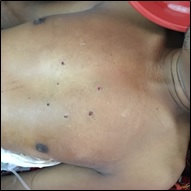Management of penetrating cardiac injury in a tertiary hospital in Northeast India
Abstract
Background: Penetrating cardiac injuries are rare and considered the most lethal of all trauma patients. Managing cardiac injuries is a great challenge for the trauma surgeons and the outcome of the treatment of such critical condition depends on the mechanism of injury, haemodynamic status of the patients at the time of presentation, heart chamber involved and other associated injuries.
Materials and Methods: This is a prospective observational study of consecutive six patients with penetrating cardiac injuries from January 2015 to December 2019 treated in Regional Institute of Medical Sciences, Imphal, India. eFAST and CT scan of the chest were the main imaging methods used for diagnosis. All patients underwent tube thoracostomy for associated haemothorax in the emergency ward.
Results: All the patients had penetrating cardiac injuries due to stabbing. Five (63.3%) patients presented with features of cardiac tamponade or with severe hypotension (systolic BP less than 80 mmHg) and one (16.7%) patient who was haemodynamically stable at the time of presentation had developed features of cardiac tamponade after 24 hours. Four patients had undergone emergency left anterolateral thoracotomy, one patient had undergone median sternotomy, and one patient underwent left anterolateral thoracotomy on the second day after admission.
Conclusion: A high index of suspicion for cardiac trauma is extremely important in patients presented with penetrating thoracic injuries or upper abdominal injuries. Computed tomography of the chest can show the haemopericardium giving detailed information of associated pulmonary injury and hemothorax. Prompt diagnosis and early surgical intervention play a vital role to save these critically injured patients.
Downloads
References
William A Nolen. “A short history of heart surgery”. American Heritage 1983;34:5.
Campbell NC, Thomson SR, Muckart DJ, Meumann CM, Van Middelkoop I, Botha JB. Review of 1198 cases of penetrating cardiac trauma. Br J Surg 1997;84(12):1737-1740. doi: https://bjssjournals.onlinelibrary.wiley.com/journal/13652168.
Smith CA, Galante JM, Pierce JL, Scherer LA. Laparoscopic transdiaphragmatic pericardial window: getting to the heart of the matter. J Am Coll Surg. 2011;213(6):736-742. doi: https://doi.org/10.1016/j.jamcollsurg.2011.09.005.
Andrade-Alegre R. Penetrating cardiac injury from a wooden knitting needle. J Emerg Med. 2012;43(4):719. doi: https://doi.org/10.1016/j.jemermed.2011.07.027.
Szentpetery S, Lower RR Changing concepts in the treatment of penetrating cardiac injuries. J Trauma 1977;(6):457-461. doi: https://doi.org/10.1097/00005373-197706000-00007.
Ivatury RR, Shah PM, Ito K, Ramirez-Schon G, Suarez F, Rohman M. Emergency room thoracotomy for the resuscitation of patients with "fatal" penetrating injuries of the heart. Ann Thorac Surg 1981;32(4):377-385. doi: https://doi.org/10.1016/s0003-4975(10)61760-2.
Flynn TC, Ward RE, Miller PW: Emergency room thoracotomy. Ann Emerg Med 1982;11(8):413-416. doi: https://doi.org/10.1016/s0196-0644(82)80037-1.
Baker CC, Thomas AN, Trunkey DD. The role of emergency room thoracotomy in trauma. J Trauma 1980;20(10):848-855. doi: https://doi.org/10.1097/00005373-198010000-00005.
Bodai BI, Smith JP, Ward RE, O'Neill MB, Auborg R. Emergency thoracotomy in the management of trauma: a review. JAMA. 1983;249(14):1891-1896. doi: https://doi.org/10.1001/jama.1983.03330380079034.
Breaux EP, Dupont JB Jr, Albert HM, Bryant LR, Schechter FG. Cardiac tamponade following penetrating mediastinal injuries: im- proved survival with early pericardiocentesis. J Trauma. 1979;19(6):461-466. doi: https://doi.org/10.1097/00005373-197906000-00008.
Isaza-Restrepo A, Bolívar-Sáenz DJ, Tarazona-Lara M, Tovar JR. Penetrating cardiac trauma: analysis of 240 cases from a hospital in Bogota, Colombia. World J Emerg Surg. 2017;12:26. doi: https://dx.doi.org/10.1186%2Fs13017-017-0138-1.
Ezzine SB, Bouassida M, Benali M, Ghannouchi M, Chebbi F, Sassi S, et al. Management of penetrating cardiac injuries in the Department of surgery, Mohamed Thahar Maamouri Hospital, Tunisia: report of 19 cases. Pan African Med J. 2012;11:54.
Aksoyek A, Tutun U, Babarglu S, Parlar I. Penetrating cardiac injuries. Turk J Trauma Emerg Surg. 2007;13(2):135-141.
Adams A, Fotiadis N, Chin JY, Sapsford W, Brohi K. A pictorial review of traumatic pericardial injuries. Insights Imaging.2012;3(4):307-311. doi: https://dx.doi.org/10.1007%2Fs13244-012-0177-9.
Nagy KK, Gilkey SH, Roberts RR, Fildes JJ, Barrett J. Computed tomography screens stable patients at risk for penetrating cardiac injury. Acad Emerg Med. 1996;3(11):1024-1027. doi: https://doi.org/10.1111/j.1553-2712.1996.tb03347.x.
Siemens R, Polk HC, Jr., Gray LA Jr., Fulton R.L., Indications for Thoracotomy Following Penetrating Thoracic Injury. J. Trauma. 1977;17(7):493-500. doi: https://doi.org/10.1097/00005373-197707000-00002.
Szentpetery S, Lower, RR, Changing Concepts in the Treatment of Penetrating Cardiac Injuries. J. Trauma. 1977;17(6):457-461. doi: https://doi.org/10.1097/00005373-197706000-00007.
Asensio JA, Berne JD, Demetriades D, Chan L, Murray J, Falabella A, et al. One hundred five penetrating cardiac injuries: a 2-year prospective evaluation. J Trauma. 1998;44(6):1073-1082. doi: https://doi.org/10.1097/00005373-199806000-00022.
Degiannis E, Loogna P, Doll D, Bonanno F, Bowley DM, Smith MD. Penetrating cardiac injuries: recent experience in South Africa. World J Surg. 2006;30(7):1258-1264. doi: https://doi.org/10.1007/s00268-005-0463-5.
Kang N, Hsee L, Rizoli S, Alison P. Penetrating cardiac injury: overcoming the limits set by nature. Injury. 2009;40(9):919-927. doi: https://doi.org/10.1016/j.injury.2008.12.008.
Embrey R. Cardiac trauma. Thorac Surg Clin. 2007;17(1):87-93. doi: https://doi.org/10.1016/j.thorsurg.2007.02.002.
O’Connor J, Ditillo M, Scalea T. Penetrating cardiac injury. J R Army Med Corps. 2009;155(3):185-190. doi: https://doi.org/10.1136/jramc-155-03-02.
Symbas PN, Gott JP. Delayed sequelae of thoracic trauma. Surg Clin North Am. 1989;69(1):135-142. doi: https://doi.org/10.1016/s0039-6109(16)44741-9.



 OAI - Open Archives Initiative
OAI - Open Archives Initiative


